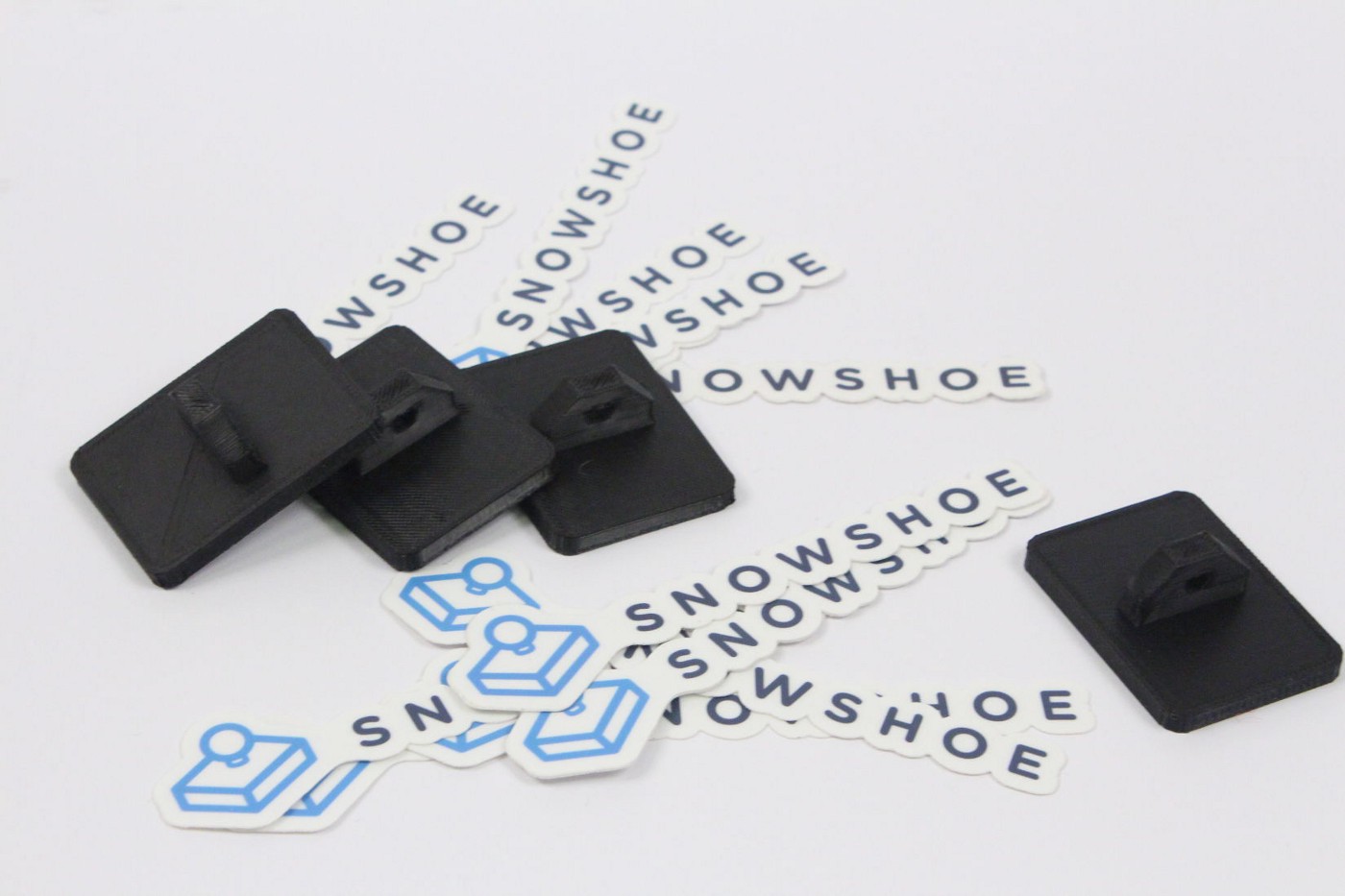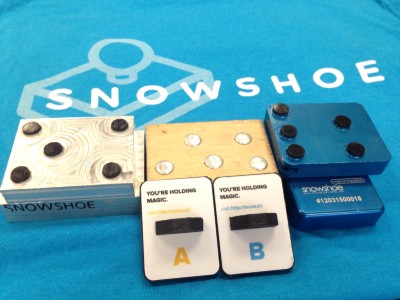AWS Startups Blog
Bringing Hardware to Life with SnowShoe Stamp

Guest post by Claus Moberg, CEO, SnowShoe
SnowShoe Stamp is a hardware startup — we make plastic stamps that unlock the digital world through a simple touch on the screen of your mobile device. Our stamps are being used to power bitcoin-based loyalty systems, enrich live event experiences, give digital life to physical toys, and more.
Humble Beginnings
SnowShoe got its start making loyalty apps for grocery stores in Wisconsin to help them track coupon redemptions at the point of sale. My co-founder Jami Morton and I started the company while in graduate school at the University of Wisconsin in Madison. After getting our first few client stores on board, we quickly realized they each had their own POS system that would require custom integration to handle coupon redemptions.
As a young startup, we couldn’t absorb the time and resource costs required to do the custom integrations, so we began to think of other ways we could achieve the same result outside the store’s POS system. However, we still had to find a way to enable the cashier to verify redemption at the point of sale. Thus, the idea of the stamp was born!
From Software to Hardware
We wanted to make the stamp easy to use: A cashier would simply touch the stamp to a coupon that was displayed on a customer’s smartphone, and our system would register the successful redemption of that coupon.

The earliest version of our stamp was literally some wood and steel screwed together in my basement. It wasn’t the prettiest thing to look at, but it was enough to get the ball rolling! From there we took it to the local hackerspace, where we received a six-hour crash course on CNC milling (a process of computerized cutting and drilling of metal). We applied what we learned about milling to turn a block of scrap aluminum into our first metal prototype. We took that prototype to our board meeting the same night, and it changed the trajectory of SnowShoe forever.
SnowShoe was no longer just another app. We now had a very novel piece of hardware. Over the ensuing months, we realized that our magical piece of aluminum (we had yet to realize that we could use a 3-D printer to print stamps out of plastic) was far more interesting than our grocery loyalty apps.
The Pivot
After much consideration, we decided to pivot the company to focus on the stamp as a developer-facing, physical-to-digital technology. We had to endure the heartache of “firing” several of our early grocery customers and the crippling uncertainty of building a developer-facing company when we ourselves were not developers.
We learned a ton through participation in two accelerator programs (TechStars Boulder in 2013, and the Disney Accelerator, powered by TechStars, in 2014). These days, SnowShoe is working with companies like Red Bull and Disney to build physical-to-digital experiences into various parts of their business such as events and physical products (i.e., toys) with a digital component.
Software-Enabled Hardware or Hardware-Enabled Software?
SnowShoe has evolved into a layer of technology that bridges the gap between the physical and digital realms. As more developers start to build on top of our technology, one of the biggest technical challenges we’ve had to face is developing a robust software platform that ensures our developers have all the power and functionality they need to build complex and robust applications.
To do so, we’ve built our backend and API in Python using Django. The rest of the business is powered almost entirely by Amazon Web Services (AWS).
We host our website and backend on EC2 instances, use RDS with PostgreSQL for our database, IAM to manage permissions, roles, and access for both software and contractors, and Cloudfront to serve assets.
In terms of what happens when you touch a stamp to the screen, it goes like this:
- Each stamp or series of stamps has a unique, five-point pattern printed a few millimeters beneath the surface. When a stamp is touched to the screen of a smart device, those coordinates are packaged up and delivered to our API, which has only one endpoint called data.
- The API takes the data and attempts to match an array containing those coordinates to a unique serial ID that identifies a specific stamp.
- At this point one of two things happens: the API either throws an error (for example, the data is invalid, or the stamp it corresponds to is not found), or it returns the unique serial number that identifies a specific stamp.
That’s when the magic kicks in. Developers have the power to take those serial numbers and do whatever they want with them. The resulting action can be as simple as a URl redirect or as complex as triggering a chain of events that leads to a bitcoin transaction.
Wisdom Gained the Hard Way
One piece of advice I would give to a young startup that wants to get set up on the AWS stack is to make sure to include redundancy in case of emergency. AWS Activate gives an abundant amount of credits and other benefits to startups that are affiliated with its Accelerator and VC partners, so there should be no expense spared in this realm. This is especially important because many small startups don’t have DevOps teams who are tasked with managing this stuff.
Redundancy is something we wish we would have implemented sooner. Before implementing redundancy, the way our application was set up had every application created by a user calling back to our API. If any of those calls failed it crashed the server, resulting in 502 errors that took down not only our application server but also our website. After implementing redundancy, these problems went away completely.
Another piece of advice I’d give is to attend the free AWS Summit conferences and learn about all the features and services AWS and Amazon Partners offer. This will fast-track your learning about how to use AWS services because you can benefit from the knowledge of product specialists rather than poking around in the console. Moreover, it will help you make better decisions about paying for services down the road. If you can’t make it to an AWS Summit, you can also sign up for Virtual Office Hours, or meet with AWS Solutions Architects at the AWS Loft locations in San Francisco or New York City.
These conferences are also a great place to start building relationships with partners, which can easily result in signing up to use their services down the road. For example, at SnowShoe we’re looking at a partnership with DataDog for equipment and application monitoring, which is a process that got started when we attended an AWS conference.
The biggest benefit we’ve received from using AWS is thanks to AWS Activate’s generous gift of credits to small startups to get up and running for little to no cost on their platform. This means we can avoid spending money on DevOps and pass the savings to our users instead.
AWS Activate has also given us a startup liaison who works inside the company. The liaison connects us directly to technical experts and specialists who help answer our complex and difficult questions. With their assistance, it’s easier to solve problems and grow our company.
In practical terms, this means we can afford to offer our API and app platform for free, which has been a great way to attract new users to try SnowShoe for little more than the cost of a couple of stamps.
SnowShoe Stamps in the Wild
One of our favorite examples of a cool application built on our stamp technology is LoveStamp, a solution for merchants to engage their fans with unique rewards.
LoveStamp is a great example of how stamps can be used in diverse ways. Not only are they building a cool loyalty/rewards system, but their system is also powered by bitcoin. This is especially cool because they help get bitcoin into the hands of consumers who might not be exposed to it otherwise.
What’s Next for SnowShoe

One of the biggest priorities we have right now is improving the UI and overall experience of building apps on our platform. It’s important for us that our users have the tools they need to be successful, so we’re excited about the prospect of improving the UX of our platform to help them get more out of SnowShoe.
In addition, we’re getting closer to mass production of our stamps, which is a process we discuss in our semi-regular “Hardware Update” email newsletter. Our stamps have changed and evolved a lot since I screwed together the first prototype in my basement.
Lessons learned:
- Keep an email list with all of your mentors, advisors, and investors on it and send them updates regularly. These “mentor updates” are insanely valuable. Send them religiously, and be ruthlessly honest in communicating bad news to your supporters.
- A personal touch goes a long way. If your users perceive that you are going above and beyond their expectations, they will reward you handsomely.
- Startups are a rollercoaster ride where the rider’s perception of every rise and drop is exaggerated tenfold. Experienced founders understand that no matter how good or bad things are today, tomorrow is another day.
It’s been a challenging but fun and rewarding experience to learn more about producing hardware — especially because when we started this company I didn’t know the first thing about i